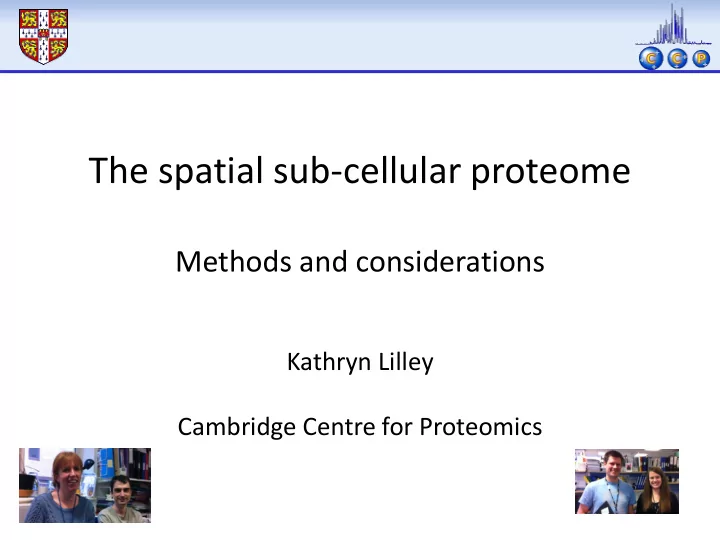

The spatial sub-cellular proteome Methods and considerations Kathryn Lilley Cambridge Centre for Proteomics
Size matters Animal cell 10-30 m m Plant cell 10-100 m m Yeast cell – 5 m m E. coli – 2 m m Giraffe neck nerve 3m
The crowded cell Courtesy of David S. Goodsell, The Scripps Research Institute
Subcellular spatial proteomics Proteins reside within discreet subcellular niches where they carry out their function. We want to know….. Some proteins reside at multiple locations and fulfil different roles in a context Where a protein is localized specific manner. If it is present in multiple locations Its interacting partners at these locations Differential subcellular distribution is controlled by: How this varies for different protein isoforms How this various for different cell types post transcriptional and post translational modification processing Dynamic changes in the above …and on a proteome -wide scale differential binding partners on location ……and on a cell wide -scale ……….and with sub -organelle resolution abundance changes Changes in subcellular dynamics are as important as changes in abundance, post translational status and interacting partners. Many proteomics protocols are not compatible with maintaining organelle integrity
Proteins as double agents Proteins that do the same job in more than one location Importins/exportins Different protein products that do the same job in more than one location MDH Proteins that are ‘inert’ in one location, but active in another Transcription factors Proteins that have different jobs in different locations Beta catenin, LDH
Where is a protein located? Fluorescence Challenges: microscopy Automated assignment to subcellular niches Link-out to databases Proteinatlas.org GO Cellular Compartment CyTof-Imaging Antibodies Fusion protein without perturbation Giesen, 2014
What proteins are nearby? (complexes, lipid rafts, sub organelle etc….) Proximity labelling Biotin ligase scale per experiment: biotinoyl- 5’AMP A + (Lysine) biotin BirA • Protein complexes * bait • Membrane environments Footprint – 10nm – • Organelle contents tethered, more for freely diffusing baits (10 um) or half a cell + fluorescein/biotin- Challenges: conjugated B arylazide/H 2 O 2 H H Conjugated horse R R P P Correct for radish peroxidase contamination Exposed tyrosine Fusions protein Footprint - 40-200nm + biotin- H H tyramide/H 2 O 2 perturbation R R (shorter half lives than P P above) Reproducibility Link-out to databases Interaction networks GO CC Rees et al Mol. Cell Prot. (2015 – in revision)
Organelle catalogues APEX Purification of subcellular niche D inter membrane mitochondrial space (IMS) matrix inner mitochondrial membrane (IMM) APEX APEX outer membrane APEX APEX APEX APEX + biotin- phenol/H 2 O 2 mitochondrial Proteinatlas.org matrix Challenges : inter membrane space (IMS) Experimental design sympathetic of contamination – Ascorbate peroxidase quantitation Smaller than BirA* No or limited steady state information Fusion protein directed to subcellular niche Link-out to databases GO CC
Whole cell maps per experiment? Correlation of protein distributions
HyperLOPIT
Christoforou – in revision
HyperLOPIT – Glycolysis (mouse Embryonic stem cells E14TGA) PFK HXK1 PFK PFK ALDOA HXK2 PKM PGK GAPDH LDH ENO PGM TPIS
As a scaffold for other spatial datasets Challenges: Fractionation Mappability to other datasets Data visualization Pattern recognition and classification Deconvolution of mixed location Interpretation of dynamic data Link-out to databases Interaction networks GO CC
p R olocGUI https://lgatto.shinyapps.io/christoforou2014/
SOX2 Interacting partners Black circles correspond to proteins listed as Sox2 interactors by Z. Gao et al (doi: 10.1074/jbc.M111.320143) SSBP IF2B1 RAGP1 Sox2 TYDP1 DLGP5 XRCC5 ATX2 PK1IP GNA1 WDR18 SYDC TEX10 NOL9 IMB1 USP9X LYAR RFA3RFA1 RBBP7 SYEP XPO1 RFA2 XPO4
Sox2, Oct4 and Nanog and their common binding partners CHD4,MTA2,SALL4,SALL1,ERR2,P66B,MTA1 Oct4 Nanog Sox2
Data Fusion Transfer learning algorithm which allows integration of heterogeneous data types Spatial proteomics HPA GO CC Output of 3 rd party software , e.g. Yloc Etc…… Primary and auxillary data Data improvement Have to combine data without compromising biological relevance of the primary data Breckels – in prep.
Common challenges within spatial ‘omics Inter-relationship - improving metabolic models and vice versa Linking the biological scales organism-tissue-cell type – single cell-subcellular compartments Are the current repositories fit for purpose? Single cell (or on cell – wide scale) Scale of validation – lack of facile validation Sampling, fractionation, Sensitivity, coverage Experimental design – can informatics help?
Recommend
More recommend